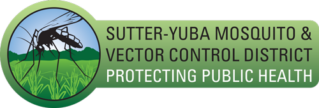Mosquitoes are one of many groups (families or orders) of flying insects common to Sutter and Yuba counties. Many look a lot like mosquitoes, both in size and color. This can make it very difficult to tell mosquitoes from other insects. These other flying insects may be an annoyance, but very few of them bite or are of public health importance.
Midges
In our area, chironomid midges are the most widespread and numerous insects that look like mosquitoes. Often they can be seen in spring and summer months swarming in tall columns in the evenings at dusk and early in the morning after sunrise. Periodically they will rest in large numbers on walls and window screens. Most of the midges in our area are shades of light green or tan in color. Some are very light in color, almost white. They can be distinguished from mosquitoes in that midges do not have a proboscis (needle-like projection) and do not bite. The larvae develop in water, such as lakes, ponds, flooded fields and slow moving streams. They can also grow in ornamental ponds and dirty abandoned swimming pools in urban areas. They can hatch in large numbers filling the water with tiny white or red colored worm-like larval stages. The red larvae are sometimes referred to as bloodworms. The Clear Lake Gnat in Lake County, California is a famous (or infamous) example of a chaoborid midge.
Crane Flies
There are many different species of crane flies in our area. Some are very small, but the one that gets the most attention is the giant crane fly. This fly is often incorrectly referred to as a “mosquito eater” or “mosquito-hawk”. They look like a giant mosquito as some species can be 1½ to 2 inches in size. Unfortunately they do not prey on mosquitoes. They don’t prey on anything. The larvae live in muddy aquatic and vegetative sources and emerge as flying adults in late winter and early spring. They don’t bite and are completely harmless. In fact, the adults have very reduced mouthparts and do not feed at all. They live a short time during which they search for a mate. After they mate and lay eggs, they die. The giant crane fly is one of the largest flies in the world.
Sand Flies
These are very small insects, often called valley black gnats, biting midges or “no-see-ums”. Sand flies are vicious daytime biters, with bites that can itch and become inflamed and take a long time to heal. Sand flies are most commonly found along the western side of the Sacramento Valley and around coastal estuaries and desert saline lake margins. They breed in sandy soils, clay, mud and along seashores. Most often, they are found near their sources as their flight range is limited.
Mayflies
Mayflies are not true flies as they belong to a different order of insects. Adults live only a few days at most and do not feed. Mayflies molt once leaving behind their exoskeleton (skin), often still attached to walls or other surfaces. Adults produce thousands of eggs which are laid on rocks or other objects in freshwater sources such as lakes, ponds, marshes and slow moving streams or shallow rivers. Mayfly larvae are an important food source for many freshwater fish.
